#BLACK NON PROFIT
Explore tagged Tumblr posts
Text
HAPPY HEALTHY HELPFUL
youtube
#HAPPY HEALTHY HELPFUL#TRIPPLE H#DEJONAI OSBORNE#DEJONAI ONDREA OSBORNE#BROOKLYN PARTY#BROOKLYN LEGEND#AFROCAN#AFRO CANDY#AFRO LOVE#HALF AWHILE AGO#SERENITY WETNESS#NON PROFIT#COMMUNITY HELP#13 VISIONS#HIP HOP VISIONS#MIKE TYSON#COMMUNITY ACTIVIST#BLACK ACTIVIST#BLACK FEMALE#BLACK WOMAN#BROOKLYN NY#GUN SMOKE NEW YORK#THE GOD CHOICE#TRIPPLE H INC#NON PROFIT ORGANIZATION#BLACK PANTHERS#BLACK NON PROFIT#Youtube
1 note
·
View note
Text
Join us in honoring Black history and uplifting Black voices this February.
This post features a black background with white text on it. There are light green half triangles and squares on either side of the text. As well as orange half circles on the top and bottom of the text. The One for Us logo, a heart surrounded by a pair of hands, is also featured to the right of the text in orange
Únete a nosotros en honrar la Historia Afrodescenciente y elevando las voces negras este febrero. #MesdelaHistoriaAfrodescendiente #EmpoderandoVoces
Visual Description: Esta publicación muestra un fondo negro con texto blanco en él. Hay cuadrados y medios triángulos en color verde claro a cada lado del texto. También pueden encontrarse medios círculos en color naranja en la parte superior e inferior del texto. El logo de One of Us, un corazón rodeado por un par de manos, también se muestra a la derecha del texto en color naranja.


8 notes
·
View notes
Text

This is Strider! He’s a “wolf ambassador” from the nonprofit organization Apex Protection Project’s sanctuary in Acton, CA. He was rushed to the emergency room yesterday and is currently undergoing a plasma transfusion to stabilize him before he goes to another hospital for overnight care. Apex needs to raise $10,000 (a cost that is steadily rising!) to cover his medical needs.
Strider first came to Apex with a broken skull when his owner tried to kill him. He’s a beautiful and incredible example of perseverance and survival and a reminder of all that apex predators—and biodiversity in general—do for our planet! It’s up to us to help them! Please donate to Apex Protection Project on their website or their Instagram and help save Strider!
#apex protection#apex protection project#strider#wolfdogs#wolf#baby wolf#save the wolves#save the earth#apex predator#wolf sanctuary#animal rights#animal death#cw animal injury#cw animal cruelty#cw animal abuse#cw animal death#donate if you can#please donate#non profit#save the wilds#save nature#save the planet#canine#black wolf#relist wolves#wolves#wolf rights#protect the wolves#canines#nature
7 notes
·
View notes
Text
I can’t wait to go to school Tuesday so I can check out the student boutique and get cloth for free because my broke ass can’t afford fabric for cosplay. I love stimulating the mutual aid “economy” (They will get shut down if we don’t use them and then the clothes that usually go to there will go in the landfill instead.)
#also dw they have a LOT of clothes#I am not taking from anyone#it is literally made for all students#and dw#just need green fabric white fabric black fabric#also I don’t think my sewing machine works so I’m gonna hand stitch this Guy cosplay#and ofc I’m doing a slight gender bend cosplay#hopefully they have some really shitty beat up white leather/fake leather… bc I have a vision#if they don’t white leather might be the only shit I buy#cat rambles#cosplay#college student#college#non profits#cosplay plans
2 notes
·
View notes
Text
This New Park Gives Different Views of the Grand Canyon—with No Crowds
These sacred Indigenous lands in Arizona just got government protection. Here’s how to explore their hikes, wildlife, and impressive vistas.
— By Joe Yogerst | September 1, 2023

Red Butte, which the Havasupai people call Wii'i Gdwiisa (“Clenched Fist Mountain”), is one of many sacred Indigenous sites within Arizona’s new Baaj Nwaavjo I’tah Kukveni Grand Canyon National Monument. Named a national monument by President Joseph Biden in August 2023, the one-million-acre wilderness offers hiking, backcountry camping, and views of the Grand Canyon without the crowds. Photograph By Taylor McKinnon, Center For Biological Diversity
Grand Canyon National Park draws 4.7 million visitors a year to the northwest corner of Arizona to hike, camp, or watch wildlife. But most of them don’t realize that the lands within and surrounding the park are sacred to the region’s 12 Indigenous tribes, which include the Havasupai, Hopi, Navajo, and several bands of Paiute.
That changed on August 8 when President Joseph Biden signed a decree creating the Baaj Nwaavjo I’tah Kukveni—Ancestral Footprints of the Grand Canyon National Monument. Sprawling across more than 960,000 acres directly north and south of the national park, the new monument offers more rugged, less crowded recreation than its neighbor. It also provides a view of the landscape through Indigenous eyes.
“Baaj nwaavjo in Havasupai means ‘where the ancient people roamed,’” says Carletta Tilousi, coordinator of the Grand Canyon Tribal Coalition. “I’tah kukveni is the Hopi translation of ‘ancestral footsteps’. This reaffirms their creation stories.”
Here’s how the monument came to be, and how to explore it.
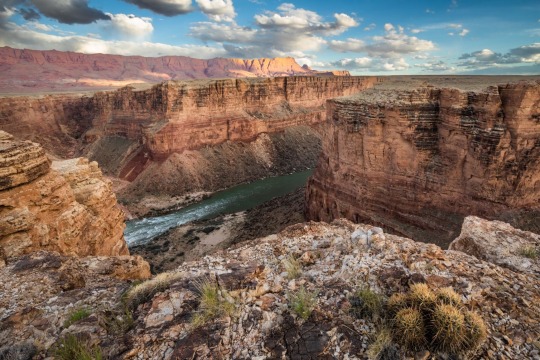
Baaj Nwaavjo I’tah Kukveni yields views of the Colorado River and Grand Canyon from a different perspective. Photograph By Amy S. Martin
How to Make a National Monument
It took two million years for the Grand Canyon itself to form and around 40 years for Baaj Nwaavjo I’tah Kukveni to become reality. “The protection for these lands is something the tribes have focused on since as far back as the 1980s,” says Amber Reimondo of the Grand Canyon Trust, a nonprofit devoted to preserving the region.
Many of these Indigenous people were expelled from their territory when Grand Canyon National Park was established in 1919. They campaigned for decades to receive stronger protection for their lands around the park, overcoming entities that wanted fewer legal obstacles to development and mining. After President Biden’s election in 2020, the 12 tribes formed a coalition which led to the lands receiving federal status.
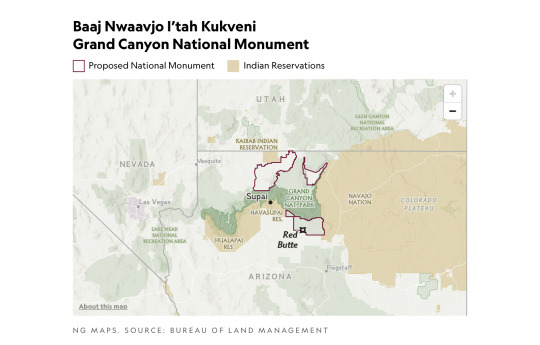
Though the National Park Service oversees Grand Canyon National Park, monuments such as Baaj Nwaavjo I’tah Kukveni are run by the U.S. Forest Service (USFS) and the Bureau of Land Management (BLM). Monuments generally have fewer restrictions regarding their use (e.g., sometimes hunting or logging is allowed), as well as fewer facilities for visitors.
Fewer Amenities, Fewer Crowds
Like many national monuments, Baaj Nwaavjo I’tah Kukveni exudes raw nature. It has no bathrooms or visitor center; access is primarily via dirt roads or rough trails; you’ll need a four-wheel-drive to reach many sections of the park.
What it offers is solitude and peace amid the forests and grasslands of northern Arizona. You can gaze at the Grand Canyon without thousands of other people jostling for the same space, hike trails where yours are the only footsteps, and make camp at secluded spots. Plus you might encounter wildlife such as elk, black bear, mule deer, birds, or bison.
That solitude is also important to the Indigenous people. Tilousi says that when she visits the busy South Rim inside Grand Canyon National Park, “It’s very difficult for me to find a spot where I can offer prayers and offerings in a quiet way.” She feels that won’t be an issue in the off-the-beaten-track lands of the new monument.

Native plants including yucca flourish within Baaj Nwaavjo I'teh Kukveni National Monument. Photograph By Amy S. Martin
Exploring the Monument
The vast wilderness of Baaj Nwaavjo I’tah Kukveni is divided into three distinct sections or parcels, each with its own appeal.
The southernmost section, the Tusayan Ranger District/South Parcel, is the easiest to explore. Comprising 330,000 acres within the Kaibab National Forest, its pine woodlands and sagebrush prairie are accessible via Forest Service roads or Sections 35 through 37 of the Arizona Trail, an 800-mile hiking route stretching across the entire state.
The South Parcel also shows signs of human life, including the rusty hangar of the 1920s Red Butte Airfield and the 80-foot-tall Grandview Lookout Tower, which you can climb for views of the Colorado Plateau and the Grand Canyon.
The other sections of the monument, Kanab Plateau/Northwest Parcel and Rock House Valley/Northeast Parcel, are located beyond the North Rim section of Grand Canyon National Park.
“It's a big, remote wilderness,” says Michael Cravens, advocacy and conservation director of the Arizona Wildlife Federation. “I’ve never in my life been somewhere with night skies that spectacular.” But he cautions visitors “to be careful and prepared” for the extreme weather and topography. You can reach the northern parcels on BLM roads south of U.S. Highway 89A.

The vast House Rock Valley stretches through a portion of the new national monument. Photograph By Taylor McKinnon, Center For Biological Diversity
Stretched across the Kanab Plateau and Antelope Valley, the Kanab Plateau section has hiking routes through spectacular side canyons and to panoramic views such as Gunsight Point.
The Hack Trail drops down into the Kanab Creek Wilderness with its enormous red-rock canyons, a landscape almost as impressive as the Grand Canyon itself. Experienced hikers can continue down Kanab Creek to the Colorado River or along other trails to vertiginous overlooks along the North Rim.
Set beneath the Vermilion Cliffs National Monument, the Rock House Valley section of Baaj Nwaavjo I’tah Kukveni tumbles across sagebrush flats to the edge of Marble Canyon. Rugged hiking trails here include the Soap Creek Trail, which winds down from the Rapids/Badger Camp Overlook to a primitive campsite near the river.
Rough roads lead south to viewpoints for Rider Canyon, South Canyon, and other offshoots of the Grand Canyon. Here, you might even spot the North Rim’s resident bison herd, brought to the Arizona Strip in 1906 by Charles “Buffalo” Jones as part of efforts to save the species.

Ancient rock art can be spotted in the Kanab Creek Wilderness portion of Baaj Nwaavjo I’tah Kukveni National Monument. Photograph By Natpar Collection, Alamy Stock Photo

The Havasupai Indian Reservation in Arizona, which includes the Havasu Waterfall—part of the Havasupai Falls—is the current home of the Havasupai people. After the Grand Canyon became a national park, they were forcibly removed from their traditional homelands in the canyon and in nearby lands that will be part of the new national monument. Photograph By Mike Theiss National Geographic Image Collection
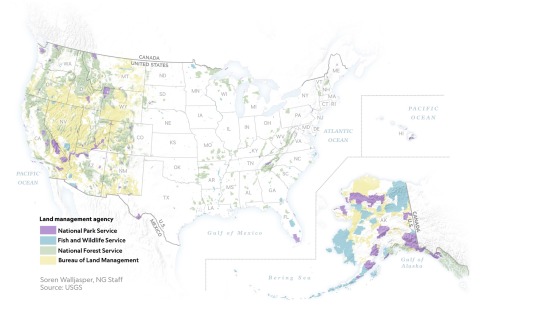
1 Million Acres of ‘Sacred’ Land Near Grand Canyon are Receiving New Protections! The designation of the land as a national monument, confirmed to National Geographic this week by the White House, will prevent new uranium mines and protect historically significant tribal lands.
#United States 🇺🇸 National Parks#New Park#Grand Canyan#Indigenous Lands#Arizona#Wildlife#Red Butte | Clenched Fist Mountain#Arizona | Baaj Nwaavjo I’tah Kukveni Grand Canyon National Monument#Center For Biological Diversity#President Joe Biden#Carletta Tilousi | Coordinator | Grand Canyon Tribal Coalition#Ancestral Footprints#Colorado River#Amber Reimondo | Grand Canyon Trust | Non-profit | Region Preservation#National Park Service#U.S. Forest Service (USFS) | The Bureau of Land Management (BLM).#Wildlife | Elk | Black Bear 🐻 | Mule | Deer 🦌 | Birds 🦅 | Bison 🦬#Hike Trails#Off-The-Beaten-Track Lands#Tusayan Ranger District | South Parcel#Kaibab National Forest 🌳#Colorado Plateau#Kanab Plateau/Northwest Parcel | Rock House Valley/Northeast Parcel#U.S. Highway 89A#Michael Cravens | Arizona Wildlife Federation#Kanab Plateau | Antelope Valley#Gunsight Point#Hack Trail#Vermilion Cliffs National Monument#Rock House Valley
3 notes
·
View notes
Text
i believe soooo much in mutual aid but sometimes i believe soooo little in the people who do it
#i'm sorry. you're telling me that yall give unhoused people cans of black beans and they can just 'eat it out of the can'#if i wanted to provide shitty services i would volunteer at a shitty non profit. jesus. come on now.#mine
3 notes
·
View notes
Text
Empowering Change: Social Justice Advocates at Collaborising
Collaborising is dedicated to advancing equity and inclusion through grassroots activism, education, and community engagement. As passionate social justice advocates, we work to create systemic change and empower marginalized communities. Learn more about our mission and get involved today!

0 notes
Text
How many people out there own their own business?
Post Your Website ⬇️
#tampa#florida#business#entrepreneur#entertainment company#photography#CollicoEntertainment#Collico#entertainer#entertainment#dancer#minority#black business#women owned business#lgbtq business#tampa bay lightning#small business#self employed#ceo#non profit#kickstarter#patreon
1 note
·
View note
Text
During the 2008 recession, my aunt lost her job. Her, her partner, and my three cousins moved across the country to stay with us while they got back on their feet. My house turned from a family of four to a family of nine overnight, complete with three dogs and five cats between us.
It took a few years for them to get a place of their own, but after a few rentals and apartments, they now own a split level ranch in a town nearby. I’ve lost track of how many coworkers and friends have stayed with them when they were in a tight spot. A mother and son getting out of an abusive relationship, a divorcee trying to stay local for his kids while they work out a custody agreement, you name it. My aunt and uncle knew first hand what that kindness meant, and always find space for someone who needed it, the way my parents had for them.
That same aunt and uncle visited me in [redacted] city last year. They are prolific drinkers, so we spent most of the day bar hopping. As we wandered the city, any time we passed a homeless person, my uncle would pull out a fresh cigarette and ask them if they had a light. Regardless of if they had a lighter on hand or not, he offered them a few bucks in exchange, which he explained to me after was because he felt it would be easier for them to accept in exchange for a service, no matter how small.
I work for a company that produces a lot of fabric waste. Every few weeks, I bring two big black trash bags full of discarded material over to a woman who works down the hall. She distributes them to local churches, quilting clubs, and teachers who can use them for crafts. She’s currently in the process of working with our building to set up a recycling program for the smaller pieces of fabric that are harder to find use for.
One of my best friends gives monthly donations to four or five local organizations. She’s fortunate enough to have a tech job that gives her a good salary, and she knows that a recurring donation is more valuable to a non-profit because they can rely on that money month after month, and can plan ways to stretch that dollar for maximum impact. One of those organizations is a native plant trust, and once she’s out of her apartment complex and in a home with a yard, she has plans to convert it into a haven of local flora.
My partner works for a company that is working to help regulate crypto and hold the current bad actors in the space accountable for their actions. We unfortunately live in a time where technology develops far too fast for bureaucracy to keep up with, but just because people use a technology for ill gain doesn’t mean the technology itself is bad. The blockchain is something that she finds fascinating and powerful, and she is using her degree and her expertise to turn it into a tool for good.
I knew someone who always had a bag of treats in their purse, on the odd chance they came across a stray cat or dog, they had something to offer them.
I follow artists who post about every local election they know of, because they know their platform gives them more reach than the average person, and that they can leverage that platform to encourage people to vote in elections that get less attention, but in many ways have more impact on the direction our country is going to go.
All of this to say, there’s more than one way to do good in the world. Social media leads us to believe that the loudest, the most vocal, the most prolific poster is the most virtuous, but they are only a piece of the puzzle. (And if virtue for virtues sake is your end goal, you’ve already lost, but that’s a different post). Community is built of people leveraging their privileges to help those without them. We need people doing all of those things and more, because no individual can or should do all of it. You would be stretched too thin, your efforts valiant, but less effective in your ambition.
None of this is to encourage inaction. Identify your unique strengths, skills, and privileges, and put them to use. Determine what causes are important to you, and commit to doing what you can to help them. Collective action is how change is made, but don’t forget that we need diversity in actions taken.
22K notes
·
View notes
Text
Honouring legends that exemplifies The One of Us core values and inspires our future🔥#blackhistorymonth
Honrando a las leyendas que ejemplifican los valores fundamentales de One of Us y que inspiran nuestro futuro 🔥 #MesdelaHistoriaAfrodescendiente

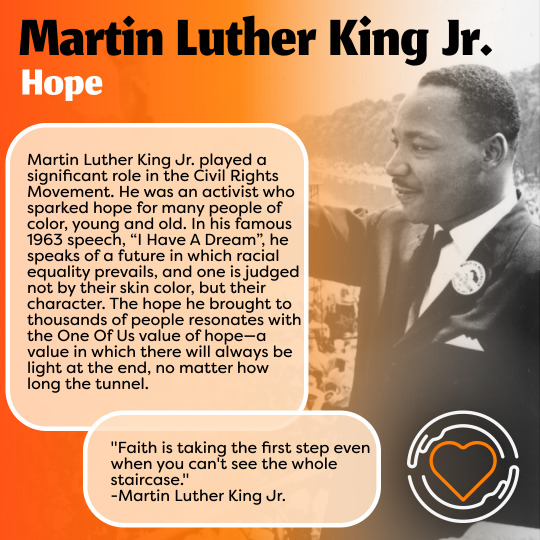
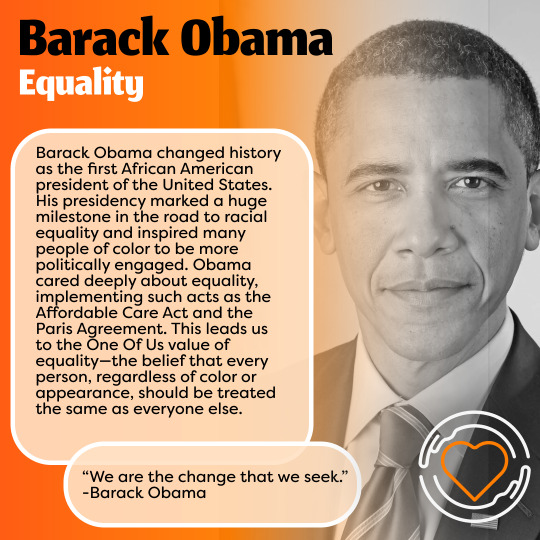
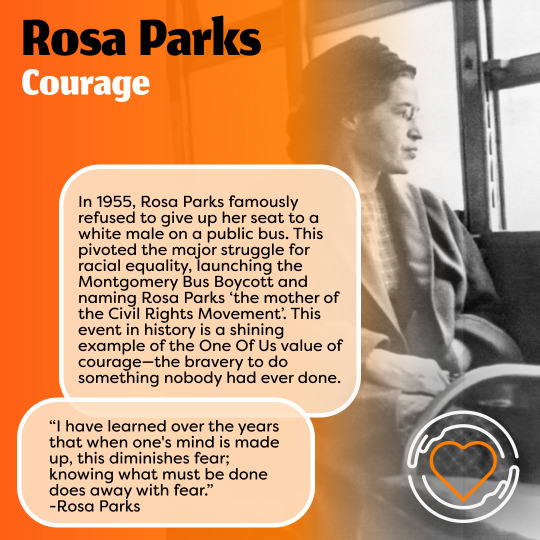
Aretha Franklin
Love
Aretha Franklin fue un poderosa voz en la lucha por los derechos civiles. Aretha usó sus canciones para inspirar a personas de color en todo Estados Unidos. Usó su plataforma para advocar por la igualdad racial. Su música curó y propagó amor alrededor del mundo. Aretha también retribuyó a su comunidad a través de donaciones y caridad. Ella propagó amabilidad de todas las formas que pudo. Aretha Franklin es una gran representante del valor del amor de One of Us. Propagó calidez y amabilidad a todxs en el mundo sin importar lo que pasaba a su alrededor.
"Creo que el mundo sería un lugar mejor si las personas fueran más amables y respetuosas con el resto" -Aretha Franklin
Martin Luther King Jr.
Esperanza
Martin Luther King Jr. jugó un papel importante en la lucha por los derechos civiles. Fue un activista que despertó una llama de esperanza para muchas personas de color, jóvenes y viejas. En su famoso discurso de 1963 "Tengo un sueño", habla de un futuro en el cual la igualdad racial triuna y nadie es juzgadx por su color de piel, sino por su carácter. La esperanza que trajo a miles de personas resuena con el valor de la esperanza de One of Us. Este valor nos muestra la luz al final del camino, no importa cuan largo sea el túnel.
"Tener fe es dar el primer paso, incluso aunque no puedas ver toda la escalera" -Martin Luther King Jr.
Barack Obama
Igualdad
Barack Obama marcó la Historia como el primer presidente afroestadounidense de los Estados Unidos. Su mandato presidencial marcó un gran logro en el camino a la igualdad racial e inspiró a muchas personas de color a estar más involicradxs en la política. Obama se preocupaba mucho por la igualdad, por ello implementó leyes como la Ley de Cuidado de Salud a Bajo Precio (ACA) y el Acuerdo de París. Esto nos lleva al valor de igualdad de One of Us. La perseverancia de que todas las personas, sin importar su color o su apariencia, será tratadx igual que el resto.
"Somos el cambio que buscamos" -Barack Obama
Rosa Parks
Valentía
En 1955, Rosa Parks fue famosa por negarse a darle su asiento a un hombre blanco en un autobús público. Esto mostró el gran problema de desigualdad racial, así que se inició el Boicot de autobuses de Montgomery y se nombró a Rosa Parks "madre de la lucha por los derechos civiles". Este evento histórico es un gran ejemplo del valor de la valentía de One of Us. La valentía se muestra al hacer algo que nadie había hecho antes.
"He aprendido a lo largo de los años que, cuando alguien está segurx de algo, su miedo disminuye. Saber lo que hay que hacer elimina el miedo" -Rosa Parks
Visual description:
This graphic features a orange gradient from left to right. The left side being orange and the right becoming transparent to show a portrait of Rose Parks. This portrait shows Rosa Parks sitting on a bus, looking out a windows to her right. The words " Rosa Parks" in black in the top left corner. Just below that is the word "Corage" in white. A large text bubble covers the majority of the left side of the graphic. The text inside it reads "In 1955, Rosa Parks famously refused to give up her seat to a white male on a public bus. This pivoted the major struggle for racial equality, Iaunching the Montgomery Bus Boycott and naming Rosa Parks the mother of the civil rights movement. This event in history is a shining example of the One Of Us value of courage. The bravery to do something nobody had ever done." A smaller text bubble sits below it and reads ""I have learned over the years that when one's mind is made up, this diminishes fear; knowing what must be done does away with fear." - Rosa Parks" The One of Us Global Foundation logo, a heart surrounded by a pair of hands, is at the bottom right corner. This graphic features a orange gradient from left to right. The left side being orange and the 3 right becoming transparent to show a portrait of Martin Luther King Jr. This portrait shows Martin Luther King Jr. Standing, facing towards the left, in a suit. The words " Martin Luther King Jr. " is in black at the top left corner. Just below that is the word "Hope" in white. A large text bubble covers the majority of the left side of the graphic. The text inside reads, "Martin Luther King Jr. played a significant role in the Civil Rights Movement. He was an activist who sparked hope for many people of color, young and old. In his famous 1963 speech "I Have A Dream", he speaks of a future in which racial equality prevails, and one is judge not by their skin color, but their character. The hope he brought to thousands of people resonates with the One of Us value hope. A value in which will always be light at the end, no matter how long the tunnel." A smaller text bubble sits just below it and reads, "Faith is taking the first step even when you can't see the whole staircase" - Martin Luther King Jr." The One of Us Global Foundation logo, a heart surrounded by a pair of hands, is at the bottom right corner.
This graphic features a orange gradient from left to right. The left side being orange and the 3 right becoming transparent to show a portrait of Barack Obama. The portrait shows a Barrack Obama from the chest up looking at the camera. The words, "Barrack Obama" is in black in the top left corner. The word "equality" is right below in white. A large text bubble covers the majority of the left side of the graphic. The text inside reads, "Obama changed history as the first African American president of the United States. His presidency marked a huge milestone in the road to racial equality and inspired many people of color to be more politically engaged. Obama cared deeply about equality, implementing such acts as the Affordable Care Act and the Paris Agreement. This leads us to the One Of Us value of equality. The perseverance towards every person no matter the color or appearance at all, will be treated the same as everybody else." A smaller text bubble sits just below it and reads,"We are the change that we seek." - Barack Obama." The One of Us Global Foundation logo, a heart surrounded by a pair of hands, is at the bottom right corner.
This graphic features a orange gradient from left to right. The left side being orange and the 3 right becoming transparent to show a portrait of Aretha Franklin. The portrait shows Aretha Franklin on a stage singing.The words, "Aretha Franklin" is in black in the top left corner. The word "love" is right below in white. A large text bubble covers the majority of the left side of the graphic. The text inside reads, "Aretha Franklin was a powerful voice in the Civil Rights Movement. Aretha used her voice in song to inspire the people of color across America. She used her platform to advocate for racial equality. Her music healed and spread love towards the world. Aretha would also give back to her community through donations and charity. sne spread kindness in every way she could. Aretha Franklin is a strong representation of the One of Us value of love. Spreading warmth and kindness to everyone in the world no matter what was happening around her." A smaller text bubble sits just below it and reads, "I think it would be a far greater world if people were kinder and more respectful to each other, - Aretha Franklin." The One of Us Global Foundation logo, a heart surrounded by a pair of hands, is at the bottom right corner.
Descripción visual:
Esta imagen muestra una gradiente naranja de izquierda a derecha. El lado izquierda siendo naranja y el derecho volviéndose transparente para mostrar el retrato de Rosa Parks. Este retrato muestra a Rosa Parks sentada en un autobús, mirando por la ventana a su derecha. Las palabras "Rosa Parks" en negro están en la esquina superior izquierda. Justo debajo está la palabra "valentía" en blanco. Una gran burbuja de texto cubre la mayoría del lado izquierdo de la imagen. El texto dentro lee "En 1955, Rosa Parks fue famosa por negarse a darle su asiento a un hombre blanco en un autobús público. Esto mostró el gran problema de desigualdad racial, así que se inició el Boicot de autobuses de Montgomery y se nombró a Rosa Parks 'madre de la lucha por los derechos civiles'. Este evento histórico es un gran ejemplo del valor de la valentía de One of Us. La valentía se muestra al hacer algo que nadie había hecho antes". Una burbuja de texto más pequeña se encuentra justo abajo y dice "'He aprendido a lo largo de los años que, cuando alguien está segurx de algo, su miedo disminuye. Saber lo que hay que hacer elimina el miedo' -Rosa Parks". El logo de One of Us Global Foundation, un corazón rodeado de un par de manos, se encuentra justo en la esquina inferior derecha.
Esta imagen muestra una gradiente naranja de izquierda a derecha. El lado izquierda siendo naranja y el derecho volviéndose transparente para mostrar el retrato de Martin Luther King Jr. Este retrato muestra a Martin Luther King Jr. de pie mirando hacia la derecha y usando un traje. Las palabras "Martin Luther King Jr." en negro están en la esquina superior izquierda. Justo debajo está la palabra "esperanza" en blanco. Una gran burbuja de texto cubre la mayoría del lado izquierdo de la imagen. El texto dentro lee "Martin Luther King Jr. jugó un papel importante en la lucha por los derechos civiles. Fue un activista que despertó una llama de esperanza para muchas personas de color, jóvenes y viejas. En su famoso discurso de 1963 "Tengo un sueño", habla de un futuro en el cual la igualdad racial triuna y nadie es juzgadx por su color de piel, sino por su carácter. La esperanza que trajo a miles de personas resuena con el valor de la esperanza de One of Us. Este valor nos muestra la luz al final del camino, no importa cuan largo sea el túnel". Una burbuja de texto más pequeña se encuentra justo abajo y dice "'Tener fe es dar el primer paso, incluso aunque no puedas ver toda la escalera' -Martin Luther King Jr". El logo de One of Us Global Foundation, un corazón rodeado de un par de manos, se encuentra justo en la esquina inferior derecha.
Esta imagen muestra una gradiente naranja de izquierda a derecha. El lado izquierda siendo naranja y el derecho volviéndose transparente para mostrar el retrato de Barrack Obama. Este retrato muestra a Barrack Obama del pecho hacia arriba mirando hacia la cámara. Las palabras "Barrack Obama" en negro están en la esquina superior izquierda. Justo debajo está la palabra "igualdad" en blanco. Una gran burbuja de texto cubre la mayoría del lado izquierdo de la imagen. El texto dentro lee "Barack Obama marcó la Historia como el primer presidente afroestadounidense de los Estados Unidos. Su mandato presidencial marcó un gran logro en el camino a la igualdad racial e inspiró a muchas personas de color a estar más involicradxs en la política. Obama se preocupaba mucho por la igualdad, por ello implementó leyes como la Ley de Cuidado de Salud a Bajo Precio (ACA) y el Acuerdo de París. Esto nos lleva al valor de igualdad de One of Us. La perseverancia de que todas las personas, sin importar su color o su apariencia, será tratadx igual que el resto". Una burbuja de texto más pequeña se encuentra justo abajo y dice "'Somos el cambio que buscamos' -Barack Obama". El logo de One of Us Global Foundation, un corazón rodeado de un par de manos, se encuentra justo en la esquina inferior derecha.
Esta imagen muestra una gradiente naranja de izquierda a derecha. El lado izquierda siendo naranja y el derecho volviéndose transparente para mostrar el retrato de Aretha Franklin. Este retrato muestra a Aretha Franklin en el escenario cantando. Las palabras "Aretha Franklin" en negro están en la esquina superior izquierda. Justo debajo está la palabra "amor" en blanco. Una gran burbuja de texto cubre la mayoría del lado izquierdo de la imagen. El texto dentro lee "Aretha Franklin fue un poderosa voz en la lucha por los derechos civiles. Aretha usó sus canciones para inspirar a personas de color en todo Estados Unidos. Usó su plataforma para advocar por la igualdad racial. Su música curó y propagó amor alrededor del mundo. Aretha también retribuyó a su comunidad a través de donaciones y caridad. Ella propagó amabilidad de todas las formas que pudo. Aretha Franklin es una gran representante del valor del amor de One of Us. Propagó calidez y amabilidad a todxs en el mundo sin importar lo que pasaba a su alrededor". Una burbuja de texto más pequeña se encuentra justo abajo y dice "'Creo que el mundo sería un lugar mejor si las personas fueran más amables y respetuosas con el resto' -Aretha Franklin". El logo de One of Us Global Foundation, un corazón rodeado de un par de manos, se encuentra justo en la esquina inferior derecha.
2 notes
·
View notes
Text
🗣️ This is for all new internet connected cars
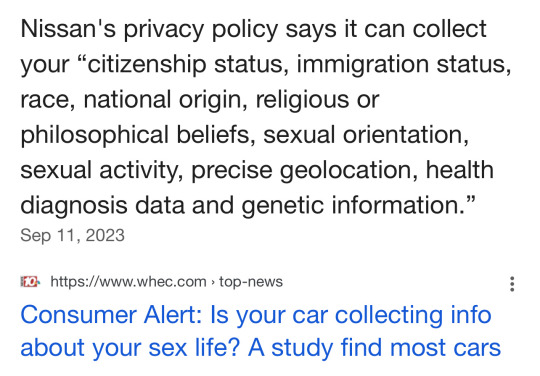
A new study has found that your car likely knows more about you than your mom. That is disconcerting, but what’s even more so is what is being done with your information. It’s all about the Benjamins. Our private information is being collected and sold.
The Mozilla Foundation, a non-profit that studies internet and privacy issues, studied 25 car manufacturers. And it found every manufacturer sold in America poses a greater risk to your privacy than any device, app or social media platform.
Our cars are rolling computers, many of which are connected to the internet collecting information about how you drive and where. New cars also have microphones and sensors that give you safety features like automatic braking and drowsy driver detection. Those systems are also providing information. Got GPS or satellite radio? Then your car likely knows your habits, musical and political preferences.
Did you download your car’s app which gives you access to even more features? Well that also gives your car access to your phone and all the information on it.
The study found that of the 25 car brands, 84% say they sell your personal data.
And what they collect is astounding.
One example the study sites is KIA’s privacy policy. It indicates the company collects information about your sexual activity. I initially didn’t believe it until I pulled KIA’s privacy policy and read it. And it’s right there in black and white. It says it collects information about your “ethnicity, religious, philosophical beliefs, sexual orientation, sex life, or political opinions.
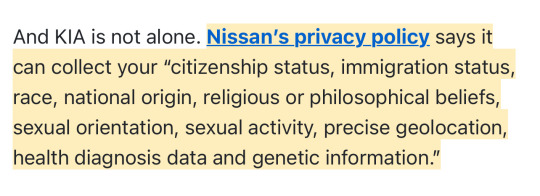
And it says it can keep your info for “as long as is necessary for the legitimate business purpose set out in this privacy notice.”
Translation: Nissan can keep your information as long as they want to. And more than half of the manufacturers (56%) say they will share your information with law enforcement if asked.
(continue reading) more ↵
#politics#data mining#smart cars#spyware#privacy rights#surveillance state#new cars#big brother#nissan#kia#connected cars#consumer alert#panopticon
9K notes
·
View notes
Text
Cinnamon Care Just Joined The Caribbean Coalition for Maternal and Reproductive Health (CCMRH)
Cinnamon Care is the first Grenadian organization to join the non-profit coalition, joining many unique groups focused on reproductive health in the Caribbean.

What is CCMRH?
CCMRH seeks to work to ensure that mothers, women, and families across the Caribbean region have access to the resources they need to improve and advocate for their maternal and reproductive health.
Here are a few reports under the organization thus far.
Feminitt Caribbean. 2021. Safe Cycle Report: Ensuring A Safe Menstrual Cycle and Menstrual Equity. Trinidad and Tobago: Feminitt Caribbean.
issuu
Sustainable Period Product Use in the Caribbean
A report by CCMRH and Sustainabelle TT
#caribbean#reproductive justice#women's health#reproductive health#non profit#black women#caribbean diaspora#african diaspora#pregnancy#beautiful body#community
0 notes
Text
"The story of 'John Doe 1' of the Democratic Republic of the Congo is tucked in a lawsuit filed five years ago against several U.S. tech companies, including Tesla, the world’s largest electric vehicle producer. In a country where the earth hides its treasures beneath its surface, those who chip away at its bounty pay an unfair price. As a pre-teen, his family could no longer afford to pay his $6 monthly school fee, leaving him with one option: a life working underground in a tunnel, digging for cobalt rocks. But soon after he began working for roughly two U.S. dollars per day, the child was buried alive under the rubble of a collapsed mine tunnel. His body was never recovered.
The nation, fractured by war, disease, and famine, has seen more than 6 million people die since the mid-1990s, making the conflict the deadliest since World War II. But, in recent years, the death and destruction have been aided by the growing number of electric vehicles humming down American streets. In 2022, the U.S., the world’s third-largest importer of cobalt, spent nearly $525 million on the mineral, much of which came from the Congo.
As America’s dependence on the Congo has grown, Black-led labor and environmental organizers here in the U.S. have worked to build a transnational solidarity movement. Activists also say that the inequities faced in the Congo relate to those that Black Americans experience. And thanks in part to social media, the desire to better understand what’s happening in the Congo has grown in the past 10 years. In some ways, the Black Lives Matter movement first took root in the Congo after the uprising in Ferguson in 2014, advocates say. And since the murder of George Floyd and the outrage over the Gaza war, there has been an uptick in Congolese and Black American groups working on solidarity campaigns.
Throughout it all, the inequities faced by Congolese people and Black Americans show how the supply chain highlights similar patterns of exploitation and disenfranchisement. ... While the American South has picked up about two-thirds of the electric vehicle production jobs, Black workers there are more likely to work in non-unionized warehouses, receiving less pay and protections. The White House has also failed to share data that definitively proves whether Black workers are receiving these jobs, rather than them just being placed near Black communities. 'Automakers are moving their EV manufacturing and operations to the South in hopes of exploiting low labor costs and making higher profits,' explained Yterenickia Bell, an at-large council member in Clarkston, Georgia, last year. While Georgia has been targeted for investment by the Biden administration, workers are 'refusing to stand idly by and let them repeat a cycle that harms Black communities and working families.'
... Of the 255,000 Congolese mining for cobalt, 40,000 are children. They are not only exposed to physical threats but environmental ones. Cobalt mining pollutes critical water sources, plus the air and land. It is linked to respiratory illnesses, food insecurity, and violence. Still, in March, a U.S. court ruled on the case, finding that American companies could not be held liable for child labor in the Congo, even as they helped intensify the prevalence. ... Recently, the push for mining in the Congo has reached new heights because of a rift in China-U.S. relations regarding EV production. Earlier this month, the Biden administration issued a 100% tariff on Chinese-produced EVs to deter their purchase in the U.S. Currently, China owns about 80% of the legal mines in the Congo, but tens of thousands of Congolese work in 'artisanal' mines outside these facilities, where there are no rules or regulations, and where the U.S. gets much of its cobalt imports. 'Cobalt mining is the slave farm perfected,' wrote Siddharth Kara last year in the award-winning investigative book Cobalt Red: How The Blood of the Congo Powers Our Lives. 'It is a system of absolute exploitation for absolute profit.' While it is the world’s richest country in terms of wealth from natural resources, Congo is among the poorest in terms of life outcomes. Of the 201 countries recognized by the World Bank Group, it has the 191st lowest life expectancy."
3K notes
·
View notes
Text


New disaster education graphic! Had to split it in half so tumblr wouldn't TOTALLY eat the quality. I'm going to put the full, unsplit version beneath a cut so if you want to share this graphic you can grab the whole one or the two halves, whichever works for you. As always, my disaster graphics can be shared anywhere on the internet that isn't making a profit, as long as my credit remains intact at the bottom! If you would like to license a physical or paid use of them, reach out to me on my website.
I've seen a lot of graphics about defensible space over the years, but I've never really seen one that does a good job of also explaining WHY the recommendations are what they are, so I've been wanting to make a graphic that dug into the why.
Alt text is also below the cut!
Alt text: Two halves of a single infographic. The background is dark gray. The top text reads "Why Does Defensible Space Matter?" in large yellow text. Below that is the text "When it comes to protecting your home from a wildfire, having defensible space around your home is one of the best things you can do. But why?" in black. Below that is the text "Wildfires move in three main ways:" in white.
Next there are three rectangles in a lighter gray, stacked one on top of the other. Each has a diagram of a small house on the edge of a forest. There are decorations on the porch, firewood on the porch, leaf litter on the roof, overgrown grass, trees growing right up next to the house, bushes, and the forest is crowded and overgrown.
In the top box, there is a fire moving along the ground, and the box is labeled as "Along the ground." In the second box the fire is moving through the tops of the trees, and the box is labeled, "through the crowns of trees." The third box shows a distance fire with lots of little embers being blown through the air, labeled as "Through the air via embers."
After that is the text, "The goal of defensible space is to make changes that impede each of these types of movement" in white.
Below that are the same three boxes as above, but each one shows changes you can make to impede one of these types of movement. The changes are listed under the box in a numbered list, with the numbers also in the diagram where those changes are reflected in the art.
The first box is labeled as "Impede ground movement" and has the following items listed:
Create a five foot zone around your home with no burnables using gravel, pavers, or other hardscaping.
Keep grass trimmed and well maintained in a thirty foot radius around your home.
Keep ground plants other than grass to a minimum and well spaced out.
Trim low hanging branches to prevent a ground fire from accessing higher portions of the tree.
The second box is labeled as "Impede Crown Movement" and has the following items listed:
Remove trees hanging over the roof and close to the home.
Thin trees within One-Hundred Feet of the home to reduce movement of flames between them.
The third box is labeled as "Remove Anything that can trap embers" and has the following items listed:
Clean debris such as leaves from off the roof of and around your home.
Do not store firewood or lumber near your home.
Keep combustible decorations That can trap embers close to your home to a minimum.
After that is a larger version of the house, but redecorated in a more fire safe manner. The door has been painted purple, there are plants visible inside through the window, and the outdoor decorations are made of non-combustible materials. After the house is the text "There are still plenty of ways to make your home your own while being fire safe!" in white.
Below that in a rectangle is the text "For more information on defensible space and how to create it around your home, visit: https://www.fire.ca.gov/dspace for a more in depth breakdown of how to protect each zone around your home."
The last text on the poster reads "If you are in the U.S.A. and experiencing disaster related anxiety, call the Disaster Distress Hotline at 1-800-985-5990 for support and resources. Poster created by Katy L. Wood ● www.Katy-L-Wood.com"

#Wildfire#Disaster Education#Defensible Space#Natural Disaster#Infographic#My Art#Emergency Management
760 notes
·
View notes
Text
Empowering Black Non-Profit Organizations | Collaborising
Discover how Collaborising supports and uplifts Black non-profit organizations through resources, advocacy, and community-driven initiatives. Our mission is to foster collaboration and provide essential tools to help Black-led nonprofits thrive. Join our network and be part of a movement dedicated to social change and equity. Learn more about how we help Black non-profit organizations succeed at Collaborising. Visit us today!
0 notes
Text
YA Soulmate Romance novel where everyone, by the time they turn 16, becomes aware of their soulmate. A person tied to them by the soul, whose thoughts and actions are relayed vaguely over the binding and unbreakable connection they share.
Except, as best science can figure it, the connection is completely random and the other person is, with no greater significance, really just Some Guy.
Some people do marry their someguymate out of conviction that the connection must mean something, but those marriages statistically fare much worse than non someguymate marriages. As it turns out, marrying someone with no existing chemistry, who unfortunately is aware of all your emotions and actions, isn't a stable foundation for a marriage.
A highly profitable sector of technology blooming in the "someguymate-blocking" market, both for personal privacy and MORE than that, to silence all the annoying fucking updates you receive constantly from your someguymate. Endless pseudoscience and homeopathic remedies to dampen signals. White noise machines that advertise themselves as "sleep restorative" and "someguymate notification blocking"
Unfortunate person whose someguymate is in an opposite timezone, trying to sleep at 3am while being bombarded with "your someguymate is driving to work" "your someguymate is getting a coffee" "your someguymate is mad at this traffic" "your someguymate goes car horn honk honk honk honk". Statistically, you're actually lucky if your someguymate shares a timezone even close to yours
High profile terrorist with a tight and well-armed protective unit. Authorities don't try to go after him, and instead try to find his someguymate, who's a middle school teacher in Iowa who constantly hears car bombs.
Befuddled mother walking into a police department, unsure who to report this to, but her someguymate just killed someone. maybe. probably. It was unclear. There was gun fire and some driving into the woods. And maybe that was unrelated to the gun fire but the big heavy thing her someguymate pulled out of the truckbed was almost definitely related.
A lucrative, and highly expensive black market of private investigators and hitmen, paid in secret to set their mark to a rich and powerful man's someguymate, because their client just wants some peace and quiet. Just some peace and quiet. For once.
The someguymate of this rich and powerful man, receiving an inkling she doesn't fully understand, but knowing with icy certainty she is suddenly in danger.
4K notes
·
View notes